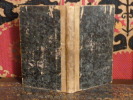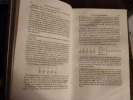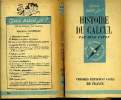-
Type
Book (19882)
Magazine (13)
Manuscript (4)
Maps (1)
Photographs (4)
-
Latest
Last 24h (2)
Last 3 days (1)
Last month (37)
Last week (9)
-
Language
English (43)
French (19850)
German (2)
Japanese (1)
Latin (1)
Polish (2)
Portuguese (1)
Russian (1)
Spanish (1)
Swedish (2)
-
Century
16th (6)
17th (37)
18th (302)
19th (3728)
20th (11872)
21st (1526)
-
Countries
Belgium (361)
Brazil (1)
Côte d'Ivoire (19)
Denmark (1352)
France (18014)
Switzerland (157)
-
Syndicate
ILAB (17291)
NVVA (26)
SLACES (26)
SLAM (15913)
SNCAO (12)
Propriétés des intégrales des équations différentielles linéaires à coefficients variables -- EDITION ORIGINALE
P., Gauthier-Villars, 1874, un volume in 4, broché, (couverture défraîchie, dos cassé, déchirure sans manque de papier au premier plat de couverture, quelques rousseurs), 70pp., (1)
---- EDITION ORIGINALE DE LA THESE de docotrat ès sciences mathématiques présentée par J. TANNERY à la Faculté des Sciences de Paris le 28 Novembre 1874 ---- "Jules Tannery (1848/1910) became professor of mechanics at the Sorbonne in 1875 and sub-director at the Ecole Normale in Paris in 1884. His researches have been in the field of analysis and the theory of functions". (Cajori p. 385) - DSB XIII pp. 249/251**5813/L7AR.Doss
IL ETAIT UNE FOIS, DEUX FOIS, TROIS FOIS...
Gallimard. 1978. In-12. Relié. Etat d'usage, Couv. convenable, Dos frotté, Intérieur frais. Env. 40 pages. Illustré de nombreux dessins en couleur.. . . . Classification Dewey : 372.7-Livre scolaire : mathématiques
(Rare) 'Enfantimages'. Pour que tu saches bien ta table de multiplication. Classification Dewey : 372.7-Livre scolaire : mathématiques
Cardinal Algebras.
New York, Oxford University Press, 1949. 8vo. Publishers full cloth with dust jacket fine condition. XII,326 pp.
First edition. The first exposition of cardinal arithmetic on an algebraic foundation.
Eléments d'arithmétique théorique et pratique.
Paris, Hachette, 1853. In-8 en demi-basane au dos lisse muet. Iv, 298 pp. Frottements sur les plats, cuir sali, coins émoussés. Intérieur avec quelques rousseurs, quelques taches d'encre marginales.
ELEMENTS DE TRIGONOMETRIE COMPRENANT DES TYPES DE CALCUL POUR LA RESOLUTION DES TRIANGLES LES FONCTIONS CIRCULAIRES ET UN CHOIX D'EXERCICES - 4ème EDITION
HACHETTE L. ET CIE. 1865. In-8. Relié demi-cuir. Bon état, Couv. convenable, Dos à nerfs, Intérieur frais. 2 PARTIES: XII + 222 + II + 308 pages - dos à 4 nerfs - titre doré au dos - reliure signé doré - plats jaspés - quelques traces au crayon de papier sur la page de faux-titre.. . . . Classification Dewey : 510-Mathématiques
+ NOTIONS GEOMETRIQUES SUR LES MOUVEMENTS ET LEURS TRANSFORMATIONS OU ELEMENTS DU CINEMATIQUE PAR ARTHUR MORIN (1872). Classification Dewey : 510-Mathématiques
Eléments d'arithmétique théorique et pratique.
Couverture souple. Broché. 276 pages. Rousseurs. Quelques annotations.
Livre. Troisième édition. Librairie Hachette, 1856.
Eléments de trigonométrie comprenant des types de calcul pour la résolution des triangles, des applications à la topographies militaire, la théorie des fonctions circulaires. Cinquième édition.
Paris, Hachette et Cie. 1875, 220x135mm, II - 227pages, reliure demi-basane. Plats papier marbré. Auteur et titre dorés au dos. Très bel exemplaire.
Cachet de bibliothèque. Pour un paiement via PayPal, veuillez nous en faire la demande et nous vous enverrons une facture PayPal
Petite arithmétique et système métrique - 8e édition
Hachette et Cie. 1878. In-24. Cartonné. Etat d'usage, Couv. légèrement passée, Dos satisfaisant, Quelques rousseurs. 331 pages. Petite annotation et tampon légèrement effacé en page de titre. Etiquette sur le dos passée.. . . . Classification Dewey : 510-Mathématiques
Classification Dewey : 510-Mathématiques
Théorie des logarithmes (conforme aux nouveaux programmes d'enseignement)
Paris, Hachette 1853 95pp., 23cm., brochure originele, rousseurs (texte toujours bien lisible), pages toujours non coupées, bon état, peu commun, W107923
Introduction à la logique - Traduit de l'anglais par J. Tremblay
P., Masson, 1969, un volume in 8, broché, couverture imprimée, 16pp., 224pp.
---- PREMIERE EDITION FRANCAISE ---- Eléments de logique, méthode déductive - Applications de la logique et de la méthodologie à la construction des théories mathématiques**6043/N5DEP
Logic, Semantics, Metamathematics. Papers from 1923 to 1938. Translated by J.H. Woodger.
Oxford, Clarendon Press, 1956. 8vo. Original publisher's cloth with dust jacket fine condition. Owner's signature (Samuel Skulsky) on front free endpaper. A very fine copy. XIV,471,(1) pp.
First English edition of 17 papers by Tarski including 'The Concept of Truth in Formalized Languages'. The papers have been revised by Tarki himself, bibliographical and historical notes have been added.
Logic, Semantics, Metamathematics. Papers from 1923 to 1938. Translated by J.H. Woodger.
Oxford, Clarendon Press, 1956. 8vo. Original publisher's cloth with dust jacket. XIV,471,(1) pp. Clean and fine.
First English edition of 17 papers by Tarski including 'The Concept of Truth in Formalized Languages'. The papers have been revised by Tarki himself, bibliographical and historical notes have been added.
Pojecie Prawdy w Jezykach Nauk Dedukcyjnych (Polish). [The Concept of Truth in Formalized Languages]. - [FOUNDING MODERN LOGICAL SEMANTICS]
Warszawa, 1933. Small 4to. Orig. printed wrappers, sunned at the edges, but otherwise near mint condition, also internally. An excellent copy. VII, (1), 116, (1, - errata) pp.
The exceedingly scarce first printing of Tarski's most important and influential work, ""The Concept of Truth in Formalized Languages"", which founded modern logical semantics.The work appeared in an extremely small number, in Polish, and many copies of the article have later been destroyed, thus, the work is of the utmost scarcity. In this seminal article the Polish-American logician and mathematician Alfred Tarski devotes himself to ""the definition of truth"". ""Its task is to construct -with reference to a given language- a materially adequate and formally correct definition of the term ""true sentence""."" (Introduction, English translation, 1956). With this work the face of logic was changed forever. The ""Concept of Truth"" constitutes a landmark event in 20th century analytic philosophy, and it ranks as one of the most important contributions to symbolic logic, semantics and philosophy of language. In this work Tarski develops the semantic theory of truth for formal languages and determines the fact that no language can contain its own truth predicate. Tarski thus concluded that the semantic theory could not be applied to any natural language. -This was later used by e.g. Davidson to construct his truth-conditional semantics, and the problems solved by Tarski are some of the same that Russell and Whitehead struggled to solve in their ""Principia Mathematica"".Tarski (1901-1983) has contributed seminally to the fields of mathematics and logic in a number of ways, and together with Frege, Russell and Gödel, he now ranks as one of the most important contributors to the field of modern logic. At the time of Franz Brentano (1838-1917), one of the philosophers of the greatest significance for contemporary philosophy and in many ways a forerunner of present-day empiricism, it was very unusual for a metaphysician to acknowledge that philosophical investigation must go hand in hand with an analysis of language. Linguistic analysis has thus been almost totally limited to the pure empiricists of philosophy, who reject all forms of metaphysics. Meanwhile, ontologists and metaphysicians have been satisfied with the ordinary language and asked no questions about its possible limitations, merely dismissing the logical faults and adding the odd neologisms. Today, however, especially within the English speaking tradition, linguistic analysis has reached a degree unheard of at the time of Brentano, and it is now generally accepted that certain logical and epistemological problems can be solved only by forsaking ordinary language and substituting it for artificially constructed language systems that follow certain principles. Thus, difficulties that appeared within earlier philosophical doctrines are meant to disappear if the theory can be formulated more precisely, and one of the most important examples is the ""adequacy theory of truth"". Tarski shows that the concept of truth of the adequacy theory can be introduced in a perfectly exact way within the formalized language systems that are equipped with precise rules of interpretation, and thus he rids us of the usual misgivings against the concept of truth. And thus he has developed one of the most important theories of modern logic.""Tarski's investigations are of singular philosophical significance for another reason as well. Within the framework of semantics, which he founded and which Carnap later developed further, it becomes possible for the first time to introduce the notion of an analytic judgment (or an analytic statement) in a form that is both sufficiently general and of the utmost precision. This notion also plays an exceptionally important role in Brentano's philosophy, especially in his studies in formal logic."" (Stegmüller, Main Currents... p. 56). When constructing a semantical system, a vocabulary of the desired object language must be determined as the first. Then formulation rules must be specified, before the rules of interpretation are laid down, and finally the rules of application are supplied. The most important rules here are the rules of truth, and the concept of truth is one of the most important semantical concepts at all, for without them no understanding of the sentences within the system would be ensured. And, of course, the truth definitions must satisfy a condition of adequacy. ""...This form of an adequacy condition that must be satisfied by every semantical truth concept goes back to the Polish logician, Stanislaw Lesniewski. But it was the logician Alfred Tarski who above all made use of this notion, and who first studied in detail the possibilities of introducing a formally exact and materially adequate concept of truth into the precise languages of science. Carnap's accounts of semantical systems rest largely on the prior works of Tarski."" (Stegmüller, p. 311). Tarski also pointed out that it is necessary for all semantical concepts, and especially for the concept of truth, to strictly separate object language and metalanguage. Otherwise we would put ourselves in the unlucky position of being able to prove both a statement and its negation at the same time. In the English translation from 1956 of Tarski's works, ""Logic, Semantics, Metamathematics"", the bibliographical information about this article is erroneous.
On The Calculus Of Relations (In: ""The Journal Of Symbolic Logic"").
(No place), The Association for Symbolic Logic, 1941. Large 8vo. Bound in blue half cloth with silver lettering to spine. In ""Journal of Symbolic Logic"", Volume 5. Small paper label to lower part of spine and upper inner margin of front board. Stamp to title-page and last leaf, otherwise internally fine. Pp. 73-89. (Entire copy: (4), 188 pp.).
First appearance of Tarski's groundbreaking work in mathematical logic. Published in 1941, it revolutionized the study of relations by introducing a formal calculus that provided a rigorous foundation for understanding and reasoning about relations.By introducing a formal calculus, Tarski provided mathematicians with a rigorous framework for reasoning about relations, leading to advancements in diverse fields of mathematics and beyond. His contributions laid the groundwork for the exploration of abstract algebra, order theory, and model theory, and found practical applications in computer science.
Direct Decompositions of Finite Algrebraic Systems.[Notre Dame Mathematical Lectures. Number 5]. - [THE STARTING POINT OF JÓNSSON-TARSKI ALGEBRAS]
(Michigan), 1947. 8vo. Ogiginal printed wrappers, black cloth back-strip. A nice and clean copy of this lithoprinted publication. (6), 64 pp. + 2 leaves of maschine-written (probably mimeographed) corrections laid in loose.
First printing of Tarski and Jónsson's important first joint publication, which constitutes the starting point of the influential Jónsson-Tarski algebras and the Jónsson-Tarski duality. The important Icelandic mathematician and logician Bjarni Jónsson (born 1920) received his PhD the year before the present publication at the University of Berkely, under the supervision of Alfred Tarski, the great Polish-American who has contributed seminally to the fields of mathematics and logic in a number of ways, and who together with Frege, Russell and Gödel now ranks as the most important contributor to the field of logic. He is thus considered one of the four greatest logicians of all times.
Statistical Curves and Parameters: Choosing an Approiate Approach.
Natick, Mass., (2000). Orig. boards. XIII,386 pp.
Cours d'arithmetique - 2e edition revue et corrigee
NONY & CIE. 1892. In-8. Relié demi-cuir. Etat d'usage, Couv. convenable, Dos satisfaisant, Quelques rousseurs. 515 PAGES - contreplats et gardes marbrés - piece de titre + filets dorés au dos - un tampon/ex libris en page de faux titre. . . . Classification Dewey : 372.7-Livre scolaire : mathématiques
Classification Dewey : 372.7-Livre scolaire : mathématiques
Cours d'arithmétique.
Paris, Librairie Vuibert, s.d. (ca 1910). 15 x 23, 515 pp., broché, état moyen (dos recollé, cachets du Collège jésuite Saint Stanislas à Mons).
Cours d'arthmétique. 4e édition.
P., Vuibert, sans date (vers 1920), in 8° broché, 515 pages.
...................... Photos sur demande ..........................


Phone number : 04 77 32 63 69
Les conjectures de Stark sur les fonctions L d'Artin en s = 0 - Notes d'un cours à Orsay rédigées par Dominique Bernardi et Norbert Schappacher , Progress in Mathematics, volume 47
Birkhauser , Progress in Mathematics Malicorne sur Sarthe, 72, Pays de la Loire, France 1984 Book condition, Etat : Bon hardcover, editor's green printed binding grand In-8 1 vol. - 143 pages
1st edition, 1983 Contents, Chapitres : Fonctions L d'Artin - La conjecture principale de Stark - Caractères à valeurs rationnelles - Les cas r(x) = 0 et r(x) = 1 - La conjecture plus fine dans le cas abélien - Le cas des corps de fonctions - Analogues p-adiques des conjectures de Stark - Bibliographie near fine copy, no markings
The Principles of the Differential and Integral Calculus. Simplified and applied to the Solution of various useful Problems in practical Mathematics and Mechanics. New Edition.
London, Longmans, Green, and Co., 1881. Small 8vo. Orig. full blindstamped cloth. VIII,245 pp. + Advertisements. Textfigs. Fine and clean.
HISTOIRE DU CALCUL / COLLECTION QUE SAIS-JE ? N°198 - LE POINT DES CONNAISSANCES ACTUELLES.
PRESSES UNIVERSATAIRES DE FRANCE. 1961. In-12. Broché. Bon état, Couv. convenable, Dos satisfaisant, Intérieur frais. 127 pages.. . . . Classification Dewey : 510-Mathématiques
Classification Dewey : 510-Mathématiques
"POUR CONTINUER LE CALCUL INTEGRAL / COLLECTION DES ""POUR COMPRENDRE"" - BIBLIOTHEQUE D'EDUCATION SCIENTIFIQUE."
DOIN G. ET CIE. 1943. In-8. Broché. Etat d'usage, 1er plat abîmé, Dos satisfaisant, Intérieur acceptable. 208 pages augmentées de quelques figures en noir et blanc in texte - 1er plat absent.. . . . Classification Dewey : 510-Mathématiques
PREFACE DE L'ABBE MOREUX. Classification Dewey : 510-Mathématiques
Que sais-je? N° 198 Histoire du calcul
Presses Universitaires de France Edition originale Première édition 31 Janvier 1946. 1946. In-12. Broché. Bon état, Plats abîmés, Dos satisfaisant, Intérieur frais. 128 pages illustrées de quelques dessins en noir et blanc. . . . Classification Dewey : 510-Mathématiques
La première encyclopédie de poche fondée en 1941 par Paul Angoulvent, traduite en 43 langues, diffusée, pour les éditions françaises, à plus de 160 millions d'exemplaires, la collection Que sais-je? est l'une des plus importantes bases de données internationnales, construite pour le grand public par des spécialistes. 3800 titres ont été publiés depuis l'origine par 2500 auteurs. Classification Dewey : 510-Mathématiques
Que sais-je? N° 367 Le calcul mécanique
Presses Universitaires de France Edition originale Première édition 2ème trimestre 1949. 1949. In-12. Broché. Bon état, Couv. convenable, Dos satisfaisant, Intérieur frais. 128 pages illustrées de quelques dessins en noir et blanc. . . . Classification Dewey : 510-Mathématiques
La première encyclopédie de poche fondée en 1941 par Paul Angoulvent, traduite en 43 langues, diffusée, pour les éditions françaises, à plus de 160 millions d'exemplaires, la collection Que sais-je? est l'une des plus importantes bases de données internationnales, construite pour le grand public par des spécialistes. 3800 titres ont été publiés depuis l'origine par 2500 auteurs. Classification Dewey : 510-Mathématiques
 Write to the booksellers
Write to the booksellers





![Pojecie Prawdy w Jezykach Nauk Dedukcyjnych (Polish). [The Concept of Truth in Formalized Languages]. - [FOUNDING MODERN LOGICAL SEMANTICS]. "TARSKI, ...](https://static.livre-rare-book.com/pictures/LLX/35832_1_thumb.jpg)
![Pojecie Prawdy w Jezykach Nauk Dedukcyjnych (Polish). [The Concept of Truth in Formalized Languages]. - [FOUNDING MODERN LOGICAL SEMANTICS]. "TARSKI, ...](https://static.livre-rare-book.com/pictures/LLX/35832_2_thumb.jpg)




